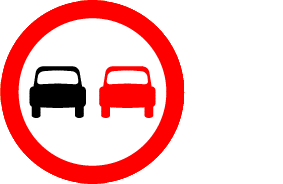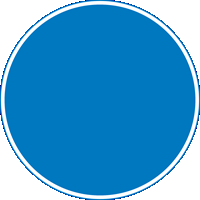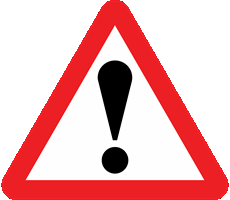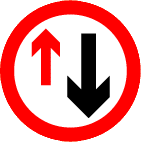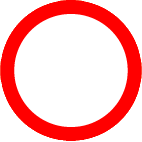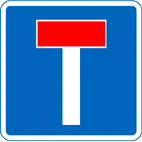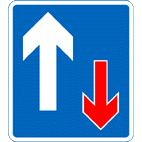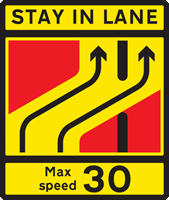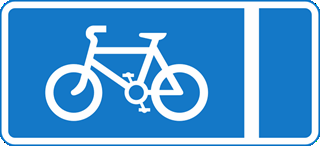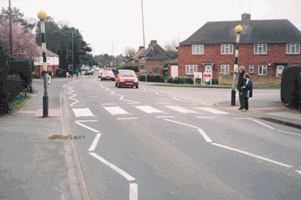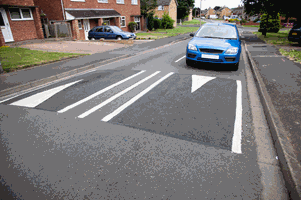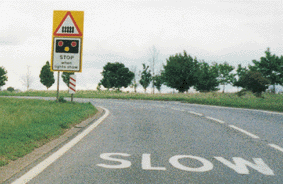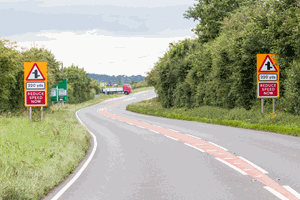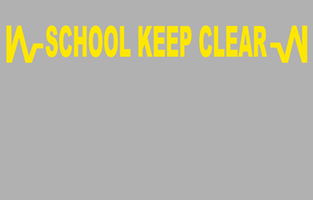You have 57 minutes to answer 50 multiple choice theory test questions. You need to answer at least 43 out of 50 questions correctly to pass. You can review your answer after each question or you can review all of your answers at the end of the test. Best of luck!
Test Quick View
Click question box to reveal the correct answer. You can print these questions out by clicking the printer icon.
Correct Answer: A, B, E
Explanation: This sign gives you a warning. The brow of the hill prevents you seeing oncoming traffic so you must be cautious. The bridge is narrow and there may not be enough room for you to pass an oncoming vehicle at this point. There is no footpath, so pedestrians may be walking in the road. Consider the hidden hazards and be ready to react if necessary.
Explanation: This sign gives you a warning. The brow of the hill prevents you seeing oncoming traffic so you must be cautious. The bridge is narrow and there may not be enough room for you to pass an oncoming vehicle at this point. There is no footpath, so pedestrians may be walking in the road. Consider the hidden hazards and be ready to react if necessary.
2. On a road where trams operate, which of these vehicles will be most at risk from the tram rails?
Mark one answer
B
C
D
Correct Answer: C
Explanation: The narrow wheels of a bicycle can become stuck in the tram rails, causing the cyclist to stop suddenly, wobble or even lose balance altogether. The tram lines are also slippery which could cause a cyclist to slide or fall off.
Explanation: The narrow wheels of a bicycle can become stuck in the tram rails, causing the cyclist to stop suddenly, wobble or even lose balance altogether. The tram lines are also slippery which could cause a cyclist to slide or fall off.
Correct Answer: B
Explanation: You should always give cyclists plenty of room when overtaking. When it's windy, a sudden gust could blow them off course
Explanation: You should always give cyclists plenty of room when overtaking. When it's windy, a sudden gust could blow them off course
B
C
D
Correct Answer: A
Explanation: Large vehicles can hide other vehicles that are overtaking, especially motorcycles which may be filtering past queuing traffic. You need to be aware of the possibility of hidden vehicles and not assume that it is safe to emerge.
Explanation: Large vehicles can hide other vehicles that are overtaking, especially motorcycles which may be filtering past queuing traffic. You need to be aware of the possibility of hidden vehicles and not assume that it is safe to emerge.
5. In which THREE of these situations may you overtake another vehicle on the left?
Mark three answers
B
C
D
E
Correct Answer: A, D, E
Explanation: At certain times of the day, traffic might be heavy. If traffic is moving slowly in queues and vehicles in the right-hand lane are moving more slowly, you may overtake on the left. Don't keep changing lanes to try and beat the queue.
Explanation: At certain times of the day, traffic might be heavy. If traffic is moving slowly in queues and vehicles in the right-hand lane are moving more slowly, you may overtake on the left. Don't keep changing lanes to try and beat the queue.
6. What is the national speed limit for cars and motorcycles in the centre lane of a three-lane motorway?
Mark one answer
B
C
D
Correct Answer: D
Explanation: Unless shown otherwise, the speed limit on a motorway applies to all the lanes. Look out for any signs of speed limit changes due to roadworks or traffic flow control.
Explanation: Unless shown otherwise, the speed limit on a motorway applies to all the lanes. Look out for any signs of speed limit changes due to roadworks or traffic flow control.
Correct Answer: D
Explanation: Travelling at the national speed limit doesn't allow you to hog the right-hand lane. Always use the left-hand lane whenever possible. When leaving a motorway get into the left-hand lane well before your exit. Reduce your speed on the slip road and look out for sharp bends or curves and traffic queuing at roundabouts.
Explanation: Travelling at the national speed limit doesn't allow you to hog the right-hand lane. Always use the left-hand lane whenever possible. When leaving a motorway get into the left-hand lane well before your exit. Reduce your speed on the slip road and look out for sharp bends or curves and traffic queuing at roundabouts.
B
C
D
Correct Answer: A
Explanation: On a motorway it is best to use a roadside emergency telephone so that the emergency services are able to locate you easily. The nearest telephone is shown by an arrow on marker posts at the edge of the hard shoulder. If you use a mobile, they will need to know your exact location. Before you call, find out the number on the nearest marker post. This number will identify your exact location.
Explanation: On a motorway it is best to use a roadside emergency telephone so that the emergency services are able to locate you easily. The nearest telephone is shown by an arrow on marker posts at the edge of the hard shoulder. If you use a mobile, they will need to know your exact location. Before you call, find out the number on the nearest marker post. This number will identify your exact location.
Correct Answer: B
Explanation: The studs between the carriageway and the hard shoulder are normally red. These change to green where there is a slip road. They will help you identify slip roads when visibility is poor or when it is dark.
Explanation: The studs between the carriageway and the hard shoulder are normally red. These change to green where there is a slip road. They will help you identify slip roads when visibility is poor or when it is dark.
10. What is the national speed limit for cars and motorcycles on a dual carriageway?
Mark one answer
B
C
D
Correct Answer: C
Explanation: Ensure that you know the speed limit for the road that you're on. The speed limit on a dual carriageway or motorway is 70 mph for cars and motorcycles, unless there are signs to indicate otherwise. The speed limits for different types of vehicles are listed in The Highway Code.
Explanation: Ensure that you know the speed limit for the road that you're on. The speed limit on a dual carriageway or motorway is 70 mph for cars and motorcycles, unless there are signs to indicate otherwise. The speed limits for different types of vehicles are listed in The Highway Code.
11. You are waiting at a pelican crossing. The red light changes to flashing amber. This means you must
Mark one answer
B
C
D
Correct Answer: C
Explanation: This light allows time for the pedestrians already on the crossing to get to the other side in their own time, without being rushed. Don't rev your engine or start to move off while they are still crossing.
Explanation: This light allows time for the pedestrians already on the crossing to get to the other side in their own time, without being rushed. Don't rev your engine or start to move off while they are still crossing.
Correct Answer: A
Explanation: If you're behind a slow-moving vehicle be patient. Wait until the restriction no longer applies and you can overtake safely.
Explanation: If you're behind a slow-moving vehicle be patient. Wait until the restriction no longer applies and you can overtake safely.
Correct Answer: A
Explanation: Signs with blue circles give a positive instruction. These are often found in urban areas and include signs for mini-roundabouts and directional arrows.
Explanation: Signs with blue circles give a positive instruction. These are often found in urban areas and include signs for mini-roundabouts and directional arrows.
Correct Answer: A
Explanation: This sign is there to alert you to the likelihood of danger ahead. It may be accompanied by a plate indicating the type of hazard. Be ready to reduce your speed and take avoiding action.
Explanation: This sign is there to alert you to the likelihood of danger ahead. It may be accompanied by a plate indicating the type of hazard. Be ready to reduce your speed and take avoiding action.
Correct Answer: C
Explanation: This sign is found at the entrance to a road that can only be used for access.
Explanation: This sign is found at the entrance to a road that can only be used for access.
Correct Answer: B
Explanation: If you use the right-hand lane in a contraflow system, you'll be travelling with no permanent barrier between you and the oncoming traffic. Observe speed limits and keep a good distance from the vehicle ahead.
Explanation: If you use the right-hand lane in a contraflow system, you'll be travelling with no permanent barrier between you and the oncoming traffic. Observe speed limits and keep a good distance from the vehicle ahead.
17. You see this line across the road at the entrance to a roundabout. What does it mean?
Mark one answer
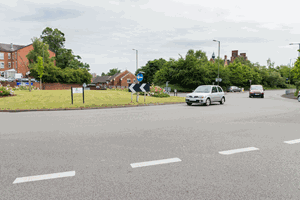
B
C
D
Correct Answer: A
Explanation: Slow down as you approach the roundabout and check for traffic from the right. If you need to stop and give way, stay behind the broken line until it is safe to emerge onto the roundabout.
Explanation: Slow down as you approach the roundabout and check for traffic from the right. If you need to stop and give way, stay behind the broken line until it is safe to emerge onto the roundabout.
Correct Answer: B
Explanation: You should stay in the left-hand lane of a motorway unless overtaking. The right-hand lane of a motorway is an overtaking lane and not a 'fast lane'.After overtaking, move back to the left when it is safe to do so.
Explanation: You should stay in the left-hand lane of a motorway unless overtaking. The right-hand lane of a motorway is an overtaking lane and not a 'fast lane'.After overtaking, move back to the left when it is safe to do so.
19. You are on a motorway. What colour are the reflective studs on the left of the carriageway?
Mark one answer
B
C
D
Correct Answer: C
Explanation: Red studs are placed between the edge of the carriageway and the hard shoulder. Where slip roads leave or join the motorway the studs are green.
Explanation: Red studs are placed between the edge of the carriageway and the hard shoulder. Where slip roads leave or join the motorway the studs are green.
20. You are on a motorway. Red flashing lights appear above your lane only. What should you do?
Mark one answer
B
C
D
Correct Answer: B
Explanation: Flashing red lights above your lane show that your lane is closed. You should move into another lane as soon as you can do so safely.
Explanation: Flashing red lights above your lane show that your lane is closed. You should move into another lane as soon as you can do so safely.
Correct Answer: D
Explanation: Before pulling up check the mirrors to see what is happening behind you. Also assess what is ahead and make sure you give the correct signal if it helps other road users.
Explanation: Before pulling up check the mirrors to see what is happening behind you. Also assess what is ahead and make sure you give the correct signal if it helps other road users.
Correct Answer: D
Explanation: Tiredness may make you more irritable than you would be normally. You might react differently to situations because of it. If you feel yourself becoming tense, take a break.
Explanation: Tiredness may make you more irritable than you would be normally. You might react differently to situations because of it. If you feel yourself becoming tense, take a break.
Correct Answer: D
Explanation: The picture of a cycle will also usually be painted on the road, sometimes with a different coloured surface. Leave these clear for cyclists and don't pass too closely when you overtake.
Explanation: The picture of a cycle will also usually be painted on the road, sometimes with a different coloured surface. Leave these clear for cyclists and don't pass too closely when you overtake.
24. Some two-way roads are divided into three lanes. Why are these particularly dangerous?
Mark one answer
B
C
D
Correct Answer: C
Explanation: If you intend to overtake you must consider that approaching traffic could be planning the same manoeuvre. When you have considered the situation and have decided it is safe, indicate your intentions early. This will show the approaching traffic that you intend to pull out.
Explanation: If you intend to overtake you must consider that approaching traffic could be planning the same manoeuvre. When you have considered the situation and have decided it is safe, indicate your intentions early. This will show the approaching traffic that you intend to pull out.
B
C
D
Correct Answer: A
Explanation: Wet weather will affect the time it takes for you to stop and can affect your control. Your speed should allow you to stop safely and in good time. If another vehicle pulls into the gap you've left, ease back until you've regained your stopping distance.
Explanation: Wet weather will affect the time it takes for you to stop and can affect your control. Your speed should allow you to stop safely and in good time. If another vehicle pulls into the gap you've left, ease back until you've regained your stopping distance.
26. What is the national speed limit on a single carriageway road for cars and motorcycles?
Mark one answer
B
C
D
Correct Answer: C
Explanation: Exceeding the speed limit is dangerous and can result in you receiving penalty points on your licence. It isn't worth it. You should know the speed limit for the road that you're on by observing the road signs. Different speed limits apply if you are towing a trailer.
Explanation: Exceeding the speed limit is dangerous and can result in you receiving penalty points on your licence. It isn't worth it. You should know the speed limit for the road that you're on by observing the road signs. Different speed limits apply if you are towing a trailer.
Correct Answer: B
Explanation: Be courteous and prepare to stop. Do not wave people across as this could be dangerous if another vehicle is approaching the crossing.
Explanation: Be courteous and prepare to stop. Do not wave people across as this could be dangerous if another vehicle is approaching the crossing.
28. You arrive at the scene of a crash. Someone is bleeding badly from an arm wound. There is nothing embedded in it. What should you do?
Mark one answer
B
C
D
Correct Answer: B
Explanation: If possible, lay the casualty down. Check for anything that may be in the wound. Apply firm pressure to the wound using clean material, without pressing on anything which might be in it. Raising the arm above the level of the heart will also help to stem the flow of blood.
Explanation: If possible, lay the casualty down. Check for anything that may be in the wound. Apply firm pressure to the wound using clean material, without pressing on anything which might be in it. Raising the arm above the level of the heart will also help to stem the flow of blood.
29. New petrol-engined cars must be fitted with catalytic converters. The reason for this is to
Mark one answer
B
C
D
Correct Answer: D
Explanation: We should all be concerned about the effect traffic has on our environment. Fumes from vehicles are polluting the air around us. Catalytic converters act like a filter, removing some of the toxic waste from exhaust gases.
Explanation: We should all be concerned about the effect traffic has on our environment. Fumes from vehicles are polluting the air around us. Catalytic converters act like a filter, removing some of the toxic waste from exhaust gases.
Correct Answer: B
Explanation: Many towns have speed humps to slow down traffic. Slow down when driving over them. If you go too fast they may affect your steering and suspension, causing you to lose control or even damaging it. Be aware of pedestrians in these areas.
Explanation: Many towns have speed humps to slow down traffic. Slow down when driving over them. If you go too fast they may affect your steering and suspension, causing you to lose control or even damaging it. Be aware of pedestrians in these areas.
Correct Answer: B
Explanation: Drive around the bend at a steady speed in the correct gear. Be aware that you might have to stop for approaching trains.
Explanation: Drive around the bend at a steady speed in the correct gear. Be aware that you might have to stop for approaching trains.
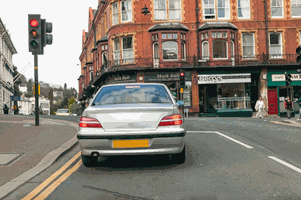
B
C
D
Correct Answer: A
Explanation: Check your nearside for cyclists before moving away. This is especially important if you have been in a stationary queue of traffic and are about to move off, as cyclists often try to filter past on the nearside of stationary vehicles.
Explanation: Check your nearside for cyclists before moving away. This is especially important if you have been in a stationary queue of traffic and are about to move off, as cyclists often try to filter past on the nearside of stationary vehicles.
Correct Answer: D
Explanation: Traffic could be turning off ahead of you, to the left or right. Vehicles turning left will be slowing down before the junction and any vehicles turning right may have to stop to allow oncoming traffic to clear. Be prepared for this as you might have to slow down or stop behind them.
Explanation: Traffic could be turning off ahead of you, to the left or right. Vehicles turning left will be slowing down before the junction and any vehicles turning right may have to stop to allow oncoming traffic to clear. Be prepared for this as you might have to slow down or stop behind them.
34. You are invited to a pub lunch. You know that you will have to drive in the evening. What is your best course of action?
Mark one answer
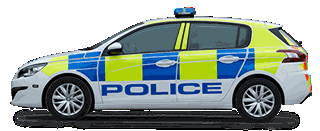
B
C
D
Correct Answer: D
Explanation: Alcohol will stay in the body for several hours and may make you unfit to drive later in the day. Drinking during the day will also affect your performance at work or study.
Explanation: Alcohol will stay in the body for several hours and may make you unfit to drive later in the day. Drinking during the day will also affect your performance at work or study.
Correct Answer: C, D
Explanation: You will be putting other road users at risk if you continue to drive when drowsy. Pull over and stop in a safe place. If you are driving a long distance, think about finding some accommodation so you can get some sleep before continuing your journey.
Explanation: You will be putting other road users at risk if you continue to drive when drowsy. Pull over and stop in a safe place. If you are driving a long distance, think about finding some accommodation so you can get some sleep before continuing your journey.
Correct Answer: D
Explanation: Fog lights will help others see you, but remember, they must only be used if visibility is seriously reduced to less than 100 metres (328 feet).
Explanation: Fog lights will help others see you, but remember, they must only be used if visibility is seriously reduced to less than 100 metres (328 feet).
Correct Answer: C
Explanation: At schools you should not stop on yellow zigzag lines for any length of time, not even to set down or pick up children or other passengers.
Explanation: At schools you should not stop on yellow zigzag lines for any length of time, not even to set down or pick up children or other passengers.
38. Your doctor has given you a course of medicine. Why should you ask how it will affect you?
Mark one answer
B
C
D
Correct Answer: B
Explanation: Always check the label of any medication container. The contents might affect your driving. If you aren't sure, ask your doctor or pharmacist.
Explanation: Always check the label of any medication container. The contents might affect your driving. If you aren't sure, ask your doctor or pharmacist.
B
C
D
Correct Answer: A
Explanation: If you're driving in high winds, be aware that the conditions might force a motorcyclist or cyclist to swerve or wobble. Take this into consideration if you're following or wish to overtake a two-wheeled vehicle.
Explanation: If you're driving in high winds, be aware that the conditions might force a motorcyclist or cyclist to swerve or wobble. Take this into consideration if you're following or wish to overtake a two-wheeled vehicle.
40. You are looking for somewhere to park your vehicle. The area is full EXCEPT for spaces marked 'disabled use'. You can
Mark one answer
B
C
D
Correct Answer: A
Explanation: It is illegal to park in a parking space reserved for disabled users.These spaces are provided for people with limited mobility, who may need extra space to get in and out of their vehicle.
Explanation: It is illegal to park in a parking space reserved for disabled users.These spaces are provided for people with limited mobility, who may need extra space to get in and out of their vehicle.
Correct Answer: A
Explanation: When parking at night, park in the direction of the traffic. This will enable other road users to see the reflectors on the rear of your vehicle. You MUST use your sidelights when parking on a road, or in a lay-by on a road, where the speed limit is over 30 mph.
Explanation: When parking at night, park in the direction of the traffic. This will enable other road users to see the reflectors on the rear of your vehicle. You MUST use your sidelights when parking on a road, or in a lay-by on a road, where the speed limit is over 30 mph.
42. Which THREE pieces of information are found on a vehicle registration document?
Mark three answers
B
C
D
E
F
Correct Answer: B, C, D
Explanation: Every vehicle used on the road has a registration certificate. The document shows vehicle details including date of first registration, registration number, previous keeper, registered keeper, make of vehicle, engine size and chassis number, year of manufacture and colour.
Explanation: Every vehicle used on the road has a registration certificate. The document shows vehicle details including date of first registration, registration number, previous keeper, registered keeper, make of vehicle, engine size and chassis number, year of manufacture and colour.
Correct Answer: A, C, D
Explanation: The licensing authorities hold the records of all vehicles and drivers in Great Britain and Northern Ireland. They need to know of any change in circumstances so they can keep their records up to date. Your health might affect your ability to drive safely. Don't put yourself or other road users at risk.
Explanation: The licensing authorities hold the records of all vehicles and drivers in Great Britain and Northern Ireland. They need to know of any change in circumstances so they can keep their records up to date. Your health might affect your ability to drive safely. Don't put yourself or other road users at risk.
Correct Answer: D
Explanation: The cost of insurance varies with your age and how long you have been driving. Usually, the younger you are the more expensive it is, especially if you are under 25 years of age.The Pass Plus scheme provides additional training to newly qualified drivers. Pass Plus is recognised by many insurance companies and taking this extra training could give you reduced insurance premiums, as well as improving your skills and experience.
Explanation: The cost of insurance varies with your age and how long you have been driving. Usually, the younger you are the more expensive it is, especially if you are under 25 years of age.The Pass Plus scheme provides additional training to newly qualified drivers. Pass Plus is recognised by many insurance companies and taking this extra training could give you reduced insurance premiums, as well as improving your skills and experience.
Correct Answer: D
Explanation: The aim of the Pass Plus course is to build up your skills and experience. It is recognised by some insurance companies, who reward people completing the scheme with cheaper insurance premiums.
Explanation: The aim of the Pass Plus course is to build up your skills and experience. It is recognised by some insurance companies, who reward people completing the scheme with cheaper insurance premiums.
Correct Answer: C
Explanation: When learning to drive it is a good idea to practise filling your car with fuel. Ask your instructor if you can use a petrol station and fill the fuel tank yourself. You need to know where the filler cap is located on the car you are driving in order to park on the correct side of the pump. Take care not to overfill the tank or spill fuel. Make sure you secure the filler cap as soon as you have replaced the fuel nozzle.
Explanation: When learning to drive it is a good idea to practise filling your car with fuel. Ask your instructor if you can use a petrol station and fill the fuel tank yourself. You need to know where the filler cap is located on the car you are driving in order to park on the correct side of the pump. Take care not to overfill the tank or spill fuel. Make sure you secure the filler cap as soon as you have replaced the fuel nozzle.
Correct Answer: D
Explanation: Only use front fog lights if the distance you are able to see is less than 100 metres (328 feet). Turn off your fog lights as the visibility improves.
Explanation: Only use front fog lights if the distance you are able to see is less than 100 metres (328 feet). Turn off your fog lights as the visibility improves.
48. You are on a three-lane motorway towing a trailer. You may use the right-hand lane when
Mark one answer
B
C
D
Correct Answer: B
Explanation: If you are towing a caravan or trailer you must not use the right-hand lane on a motorway with three or more lanes, except in certain circumstances, such as lane closures.
Explanation: If you are towing a caravan or trailer you must not use the right-hand lane on a motorway with three or more lanes, except in certain circumstances, such as lane closures.
49. You claim on your insurance to have your car repaired. Your policy has an excess of £100. What does this mean?
Mark one answer
B
C
D
Correct Answer: C
Explanation: Having an excess on your policy will help to keep down the premium, but if you make a claim you will have to pay the excess yourself, in this case £100.
Explanation: Having an excess on your policy will help to keep down the premium, but if you make a claim you will have to pay the excess yourself, in this case £100.
B
C
D
Correct Answer: B
Explanation: If the airbag activates near a baby seat, it could cause serious injury or even death to the child. It is illegal to fit a rear-facing baby seat into a passenger seat protected by an active frontal airbag. You MUST secure it in a different seat or deactivate the relevant airbag. Follow the manufacturers advice when fitting a baby seat.
Explanation: If the airbag activates near a baby seat, it could cause serious injury or even death to the child. It is illegal to fit a rear-facing baby seat into a passenger seat protected by an active frontal airbag. You MUST secure it in a different seat or deactivate the relevant airbag. Follow the manufacturers advice when fitting a baby seat.


